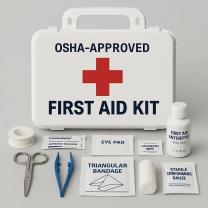What is mandatory OSHA training?
Mandatory OSHA training refers to the training programs and courses that employers are required to provide to their employees to ensure a safe and healthful workplace. The Occupational Safety and Health Administration (OSHA) sets specific training requirements for various industries to reduce workplace hazards and protect the well-being of workers. The goal of mandatory OSHA training is to equip employees with the knowledge and skills needed to recognize and address potential workplace hazards.
Key points regarding mandatory OSHA training include:
Specific Standards for Training:
- OSHA has developed specific standards that outline the training requirements for different industries and activities. These standards identify the topics, duration, and frequency of training needed to comply with OSHA regulations.
Employee Categories:
- OSHA training requirements vary based on the nature of the work and the potential hazards employees may encounter. Training is often categorized by job roles and responsibilities.
Hazard Communication (HazCom) Training:
- OSHA's Hazard Communication Standard (29 CFR 1910.1200) requires employers to provide training on hazardous chemicals in the workplace. This includes information on labeling, Safety Data Sheets (SDS), and safe use of chemicals.
Bloodborne Pathogens Training:
- Employers with employees at risk of exposure to blood or other potentially infectious materials must provide training on bloodborne pathogens. This includes information on preventing exposure and appropriate response measures.
Respiratory Protection Training:
- In workplaces where employees use respiratory protection equipment, OSHA requires training on the proper use, maintenance, and limitations of respiratory protective devices.
Lockout/Tagout Training:
- Employees working with machines and equipment that may require lockout/tagout procedures must receive training on the safe use of these procedures to prevent unexpected startup.
Confined Space Training:
- Workers involved in activities within confined spaces must undergo training to understand the hazards associated with confined spaces and the proper safety procedures.
Fall Protection Training:
- Employees who work at heights must receive training on fall protection measures, including the proper use of fall protection equipment.
Electrical Safety Training:
- OSHA requires training on electrical safety for employees exposed to electrical hazards in the workplace.
Emergency Response Training:
- Employees involved in emergency response activities, such as fire brigades, must receive specific training based on their roles and responsibilities.
Forklift and Powered Industrial Truck Training:
- Operators of forklifts and other powered industrial trucks must undergo training to ensure safe operation and prevent accidents.
Employers are responsible for identifying the specific training needs within their workplace based on OSHA regulations and providing the necessary training to employees. Training should be conducted during initial job assignments, when new hazards are introduced, and periodically to ensure ongoing awareness.
It's important for both employers and employees to be aware of the specific OSHA training requirements relevant to their industry and job responsibilities. Non-compliance with mandatory OSHA training standards can result in penalties for employers and can compromise the safety of workers.
What topics or courses fall under mandatory OSHA training?
Mandatory OSHA training requirements vary depending on the specific industry, hazards present in the workplace, and the tasks employees perform. However, there are some general topics and courses that are commonly required or highly recommended by OSHA:
General Safety:
- Hazard Communication: This training covers identifying hazardous materials in the workplace, understanding their labels and safety data sheets (SDS), and knowing proper handling procedures.
- Bloodborne Pathogens: This training is mandatory for workers who have a reasonable chance of occupational exposure to blood or other potentially infectious materials. It covers safe work practices, personal protective equipment (PPE) use, and post-exposure procedures.
- Respiratory Protection: This training is required for any employee who uses a respirator to protect themselves from airborne hazards. It covers respirator selection, fitment, use, maintenance, and limitations.
Construction Safety:
- Fall Protection: This training is mandatory for workers who risk falling from heights of 6 feet or more. It covers fall prevention systems, working safely on ladders and scaffolds, and proper use of fall arrest equipment.
- Confined Spaces: This training is required for workers who enter confined spaces like tanks, silos, or vats. It covers identifying hazards, safe entry and exit procedures, and emergency response plans.
- Excavation Safety: This training is mandatory for workers involved in excavation activities. It covers trenching hazards, shoring and sloping requirements, and safe work practices around excavations.
Other Common Topics:
- Electrical Safety: Covers safe work practices around electrical hazards, lockout/tagout procedures, and first aid for electrical shock.
- Ergonomics: Provides information on preventing musculoskeletal disorders, proper lifting techniques, and workstation design.
- Heat Stress: Teaches how to recognize and prevent heat-related illnesses, such as heat stroke, in hot work environments.
- Personal Protective Equipment (PPE): Covers the selection, fitment, use, care, and maintenance of various types of PPE.
Additional Resources:
- OSHA Training Institute: Offers a variety of online and in-person training courses on various OSHA topics.
- eCFR (Electronic Code of Federal Regulations): Provides access to the full text of OSHA standards and regulations, which can help you determine specific training requirements for your workplace.
- State OSHA plans: Some states have their own OSHA plans with additional training requirements.
Remember: This is not an exhaustive list, and specific training requirements may vary. It's crucial to consult the relevant OSHA standards and regulations for your industry and workplace to ensure you are complying with mandatory training requirements.
I encourage you to explore the resources provided and reach out to OSHA or a qualified safety professional if you have any specific questions about mandatory training requirements for your workplace.
I hope this information helps!











